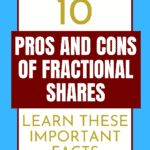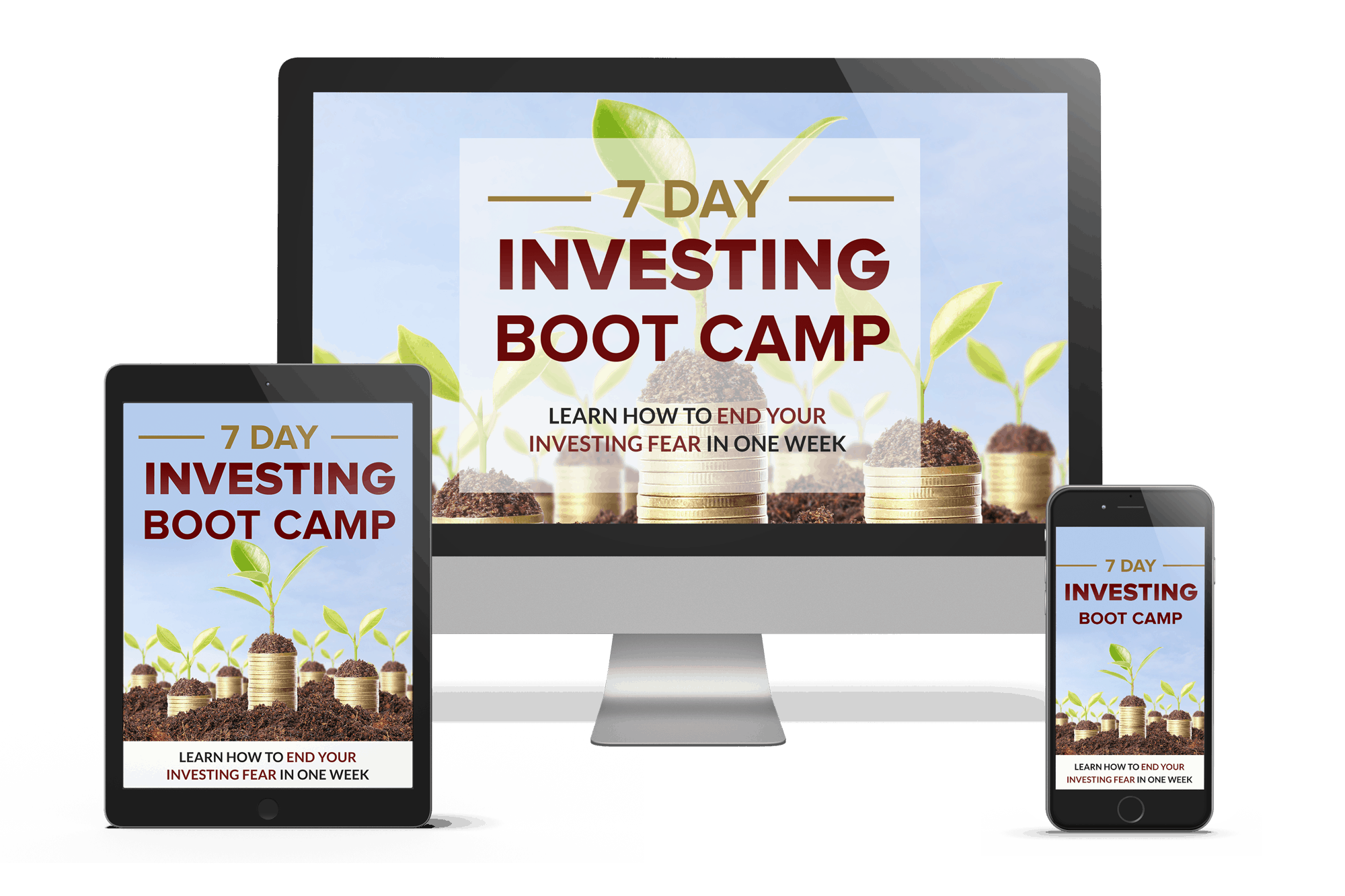THIS POST MAY CONTAIN AFFILIATE LINKS. PLEASE SEE MY DISCLOSURES. FOR MORE INFORMATION.
Are you interested in investing in individual stocks but don’t have enough money buy any shares?
In years past, you would have to wait until you had more money to start investing.
But thanks to fractional share programs, you can buy stocks with small dollar amounts.
In this post, I share with you the biggest pros and cons of fractional share investing.
Table of Contents
10 Critical Pros And Cons Of Fractional Shares
5 Pros Of Fractional Shares
There are some great reasons why you want to take advantage of fractional share investing.
Here are the biggest ones.
#1. Invest With A Small Amount Of Money
By far the biggest advantage of fractional shares is the fact you can invest with very little money.
Even if you only have $5 a month to invest, you can buy stocks that you otherwise wouldn’t be able to.
This is because you have the ability to buy partial shares of stock.
In the past, if you wanted to invest in the stock market, you could only buy whole shares and as a result needed precise amounts of money.
For example, if a stock was trading for $33 per share and you wanted to own 50 shares, you needed to have $1,650 plus the trading commission.
By being able to buy fractional shares of stock, you can buy any amount of stock based on how much money you have.
This opens the door to many small investors to get started with building wealth.
#2. Invest In Higher Priced Stocks
Before fractional investing platforms came around, buying an expensive stock was out of the question unless you had a lot of money.
In some cases where high stock prices were so high, individual investors had to resort to buying a single share at a time.
But when you buy fractional shares, you can invest in stocks with very high share prices.
For example, as of this writing, Amazon stock trades at more than $3,000 a share.
You need to have $3,000 just to buy one share of stock!
And if you want to buy 100 shares, you are going to need to be wealthy!
With fractional shares, you can invest $100 in Amazon and own a partial share.
Over time, as you dollar cost average, you will increase the size of your position and eventually will own 1 whole share and in time, more.
But while you are waiting for this to happen, the money you have invested is growing in value as the price of stock rises.
#3. Invest A Specific Dollar Amount
In the past, you needed to set up your investments based on the number of shares you could buy.
If you wanted to own 100 shares of a stock that trades for $30 a share, you needed $3,000 to invest.
Or if you had $500 to invest, you could buy 16 shares.
By investing in partial shares, you can just focus on the amount of money you have and not the individual share prices.
If you have $700, you can buy $700 worth of stock.
This makes investing much less time consuming.
#4. Great For Automatic Investing
Fractional shares work great for automatic investing.
In the past, automatic investing for individual stocks was not possible.
If you wanted to do this, you had to invest in mutual funds where you could buy partial shares.
But now many brokerage firms let you auto invest in stocks.
You can set a monthly dollar amount and know that all of your money is being put to work.
If you tried to create your own automatic investment plan in the past, there would always be extra money left, sitting in cash, until you had enough to buy another share of stock.
#5. Easier To Get To A Desired Asset Allocation
The final major benefit is you can fine tune your asset allocation a lot easier.
If your allocation is off by 5%, you can quickly do the math to see the dollar amount you need to invest in the underweighted portion of your portfolio.
- Read now: Discover the right asset allocation for you
- Read now: Learn the importance of a diversified portfolio
Had you not been able to invest this way, you would have to add in the extra step of seeing how many shares you could buy with the money you needed and even then, you would be off a little bit.
With fractional share programs, you can more easily build a diversified portfolio.
5 Cons Of Fractional Shares
As great of an idea fractional shares are, there are downsides.
Here are the biggest drawbacks of fractional shares.
#1. Can Cost More If You Pay Fees
Many brokers charge a fee for buying stock and some charge additional fees for fractional share programs.
If you are buying fractional shares, you will be paying more in fees, which means less money goes towards your investment.
For example, if your broker charges $5.95 for a stock purchase and you buy 100 shares, you pay $5.95.
But if you buy the equivalent amount each month, so 8.33 shares a month, you are paying $71.40 in fees over the course of a year.
Another way to look at this is by percent.
Your one time purchase has a purchase fee of 0.40%, assuming the stock price is $15 per share.
Your monthly purchases have a fee of 4.76% each month.
This is huge.
If you are going to invest this way, you need to make sure your broker doesn’t charge trading fees.
#2. Complicate Tax Returns
When you trade fractional shares, you end up having multiple tax lots, which adds to the work of figuring out your tax return.
Not only do you have more tax lots than you otherwise would have, but depending on how you sell, whether first in, first out, or other method, there is work to be done.
And if you do sell, you have to be aware of wash sale rules, which can disqualify any losses you might have otherwise been able to take.
Finally, if the stock you buy pays dividends and you reinvest this dividend, you are adding yet another tax lot to review.
The bottom line is this can get complicated quickly for your tax professional or yourself if you do your own taxes.
#3. Selling By Tax Lot Is Cumbersome
This issue might not seem big to you, but it could be if you do your own taxes.
And even if you hire a CPA, the fee for completing your taxes could be higher thanks to fractional shares.
This is because you are going to have a lot of tax lots to go through.
A tax lot is your tax basis for every purchase you make and is used when you sell to determine if you have a capital gain or a capital loss.
For example, let’s say you bought $50 worth of stock each month for a year.
You have 12 tax lots.
If you invest for 10 years, you now have 120 tax lots.
And this doesn’t account for any dividend payout you might have reinvested along the way.
Now when you go to sell some shares, you have to match up the number of shares you are selling with enough tax lots.
So if you sell 100 shares, you have to find enough tax lots where you bought 100 shares.
And chances are, this won’t work out perfectly, so you will have remaining tax lots as a result.
#4. Not All Brokers Offer Fractional Investing
Before you get excited about the idea of fractional investing, know that not all brokers offer this option.
The good news is however, more and more are.
So if your goal is to invest in individual stocks, make sure one of the first questions you ask about opening a brokerage account is if they offer fractional investing.
#5. Potential To Miss Out On Dividends
The final drawback to fractional shares is the potential to miss out on dividends.
When you buy fractions of shares, there are some cases where it doesn’t make sense to credit you with a dividend payment, even if you enroll in a dividend reinvestment plan.
- Read now: Learn how to get started with dividend investing
- Read now: Learn 10 pros and cons of dividend stocks
This usually occurs when you own a very small fraction of a share of stock and the resulting dividend is less than a penny.
But in some cases, it could be a penny.
While it doesn’t sound like a big deal to miss out on this income, remember that it is your money and over time, that dividend would grow into a larger amount.
It will never be worth thousands of dollars, but could compound into tens of dollars or more.
The Best Fractional Share Investing Platform
While many brokers allow you to buy partial shares, in my opinion the best is M1 Finance.
- Read now: Learn more about M1 Finance
In addition to offering fractional shares, they charge zero fees, and you can invest small amounts of money.
New investors will enjoy M1 Finance as they have pre-built pies or portfolios.
Each of these is a diversified portfolio that invests based on a theme.
Just pick a pie and set up an automatic investment.
If you don’t want to use a pre-built portfolio, you can build a custom portfolio.
This is what I did.
I have a dividend stock portfolio where I invest in 10 high paying dividend stocks each month.
If you want to learn more about M1 Finance or open an account, click the link below.
Final Thoughts
There are the most important pros and cons of fractional shares you need to know.
Know that if you are interested in investing in stocks, being able to buy fractional shares is a godsend and you should look for a broker that offers this type of investing for free.
While there are drawbacks, the benefits outweigh them and the result is a great way to build wealth more easily.
- Read now: Learn the pros and cons of small cap stocks
- Read now: Discover the investing basics you need to know
- Read now: Find out your risk tolerance to be a better investor
I have over 15 years experience in the financial services industry and 20 years investing in the stock market. I have both my undergrad and graduate degrees in Finance, and am FINRA Series 65 licensed and have a Certificate in Financial Planning.
Visit my About Me page to learn more about me and why I am your trusted personal finance expert.





